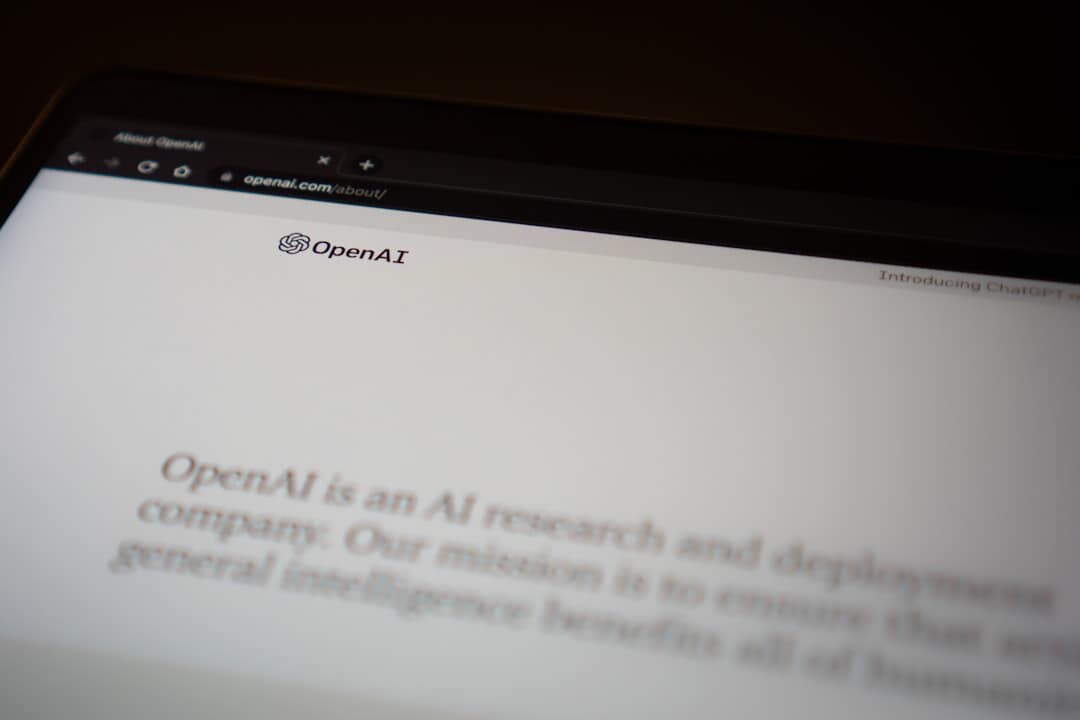Understanding the whirlwind OpenAI Product Strategy requires looking closely at its core approach. Many startup founders and tech leaders feel the pressure to keep up with OpenAI Product Strategy. You see the headlines, the breakthroughs, and wonder how they steer such a powerful ship; examining their approach reveals insights applicable far beyond just their organization.
It’s a dynamic field where the ground shifts constantly, heavily influencing their business strategy. What seems like cutting-edge AI today might feel commonplace tomorrow. This reality significantly shapes the OpenAI product strategy, forcing a flexible and forward-looking mindset.
We’ll explore how they handle this pace and what lessons other businesses can learn. This deep dive aims to shed light on the thinking behind one of the most watched companies in the AI space. Understanding their methods can help others leverage AI more effectively.
Table of Contents:
- The Core Philosophy: Embrace the Exponential Curve
- Building the Engine: Models, Ensembles, and Evals
- The User Interface: Why Chat Endures
- Powering the Business: Enterprise Focus and Partnerships
- Building the Future: AGI-like Experiences and Development
- Developing Your Own AI Product Strategy
- Conclusion
The Core Philosophy: Embrace the Exponential Curve
OpenAI Product Strategy operates under a principle some call “model maximalism,” a core idea influencing much of their product thinking. It stems from a belief that AI models improve at a staggering speed, faster than many anticipate. This impacts every facet of their AI development.
This perspective means designing for capabilities that are just appearing on the horizon. It accepts that current limitations will soon vanish. Consequently, extensive workarounds for today’s model weaknesses might represent wasted effort in the rapidly evolving AI industry.
This philosophy pushes the team to focus on foundational advancements rather than short-term fixes. It’s a bet on the accelerating pace of artificial intelligence progress itself. This approach defines much of OpenAI’s product direction.
Today’s AI is the Worst You’ll Ever Use
Kevin Weil, OpenAI’s Chief Product Officer, captures this idea starkly, suggesting the AI models we use now are the least capable we’ll encounter moving forward. Think about that for a moment. It implies exponential progress is the norm, not the exception, for the OpenAI Product Strategy capabilities.
The pace has quickened dramatically in the AI space. What used to take many months between model upgrades now happens faster. Newer AI models represent substantial leaps in what artificial intelligence can achieve, impacting everything from natural language understanding to image generation.
Costs are also falling rapidly alongside capability jumps, creating opportunities for wider adoption and new applications. This dual trend opens up new possibilities constantly. Building for tomorrow’s AI capabilities becomes a central tenet of OpenAI’s product strategy, prioritizing long-term potential over present constraints.
Iterative Deployment: OpenAI Product Strategy is Learning in Public
Another key aspect of OpenAI’s approach is shipping early and refining AI products with users. They prefer an iterative deployment model. This means not waiting for perfection behind closed doors, a contrast to traditional software company practices.
Instead, they release products like ChatGPT and learn alongside their massive user base, refining the user experience based on real-world interaction. This reflects an understanding that the full potential of new AI technology is discovered through use and feedback. It’s a collaborative evolution that accelerates AI development.
This philosophy naturally affects their roadmapping; while directions are set, OpenAI Product Strategy plans are expected to change as technology evolves and user feedback flows in. The planning process itself is valued more than sticking rigidly to an outdated plan, echoing a famous Dwight D. Eisenhower quote about plans versus planning. This agility is critical in the fast-moving AI industry.
Building the Engine: Models, Ensembles, and Evals
The foundation of the OpenAI offers rests on sophisticated AI models. But it’s not just about creating one giant, all-powerful AI model. Their strategy involves a more nuanced approach to leverage AI effectively through diverse AI technologies.
They focus on creating systems that combine different types of AI models, including both large foundation models and potentially smaller models for specific tasks. This allows for specialization, efficiency, and better cost optimization. Evaluating these complex systems through rigorous processes is also a crucial piece of the puzzle for successful AI products.
This multi-faceted approach involves intense machine learning research and development. It requires expertise in training, deploying, and managing various AI models. The goal is to build a robust and flexible AI ecosystem.
More Than One Brain: The Power of Model Ensembles
OpenAI product strategy often uses ensembles of specialized AI models working together, a core part of their system design. Think of it like a company with different experts. You wouldn’t ask your accountant to design a marketing campaign for social media.
Similarly, OpenAI deploys multiple AI models as part of their AI solutions. Some might be fine-tuned for specific tasks requiring high accuracy, perhaps in complex data processing scenarios. Others might be chosen for speed or cost efficiency on simpler tasks, contributing to overall cost optimization.
These diverse AI models collaborate to tackle complex problems, mirroring how human organizations operate effectively. OpenAI even uses this internally to manage customer service for millions with a relatively small team. It’s a practical application of using the right AI tools for the job within their AI ecosystem.
The Critical Skill: Writing Effective Evals
How do you know if these complex AI systems are working well and meeting performance goals? This is where evaluations, or “evals,” come in. Writing effective evals is becoming a core competency for teams building AI products, crucial for measuring progress.
Evals are structured tests measuring an AI model’s performance on specific tasks, essential for data processing and analysis. They reveal where an AI model shines, perhaps achieving near-perfect accuracy in text generation. They also highlight where it struggles, maybe only hitting 60% accuracy in nuanced sentiment analysis, guiding further AI development.
This data is fundamental; it directly shapes product design decisions and the overall customer experience. You can only optimize what you can measure, making high-quality evals critical for pushing AI capabilities forward. OpenAI even provides resources on GitHub for their Evals framework, promoting standardized testing.
The Role of Fine-Tuning
General-purpose AI models are powerful, but sometimes specialization is necessary for optimal performance. OpenAI recognizes that generic models often can’t match the performance of those fine-tuned for specific domains or tasks. This understanding is key to their business strategy and providing users with effective AI solutions.
As artificial intelligence becomes more widespread, fine-tuned models will likely increase across industries. This means product teams may need closer integration with machine learning experts. These experts can customize powerful AI models for specific use cases, delivering superior results and helping businesses gain competitive advantages.
This trend is already visible within foundation model companies like OpenAI, but it’s expected to spread as more organizations leverage AI technology. Fine-tuning helps adapt powerful AI technology to unique business needs, unlocking new value. It allows businesses to harness advanced AI for very specific challenges.
The User Interface: Why Chat Endures
Many predicted the chat interface was just a stepping stone for interacting with AI. Some saw it as a basic way to interact with artificial intelligence, soon to be replaced by more graphical or structured interfaces. But OpenAI sees lasting value in chat, especially for complex interactions.
The unstructured nature of chat offers surprising advantages for language processing. It mirrors human communication closely, allowing for flexibility and nuance. This adaptability makes it a powerful tool for interacting with increasingly intelligent systems capable of understanding natural language.
This belief influences their focus on improving conversational AI models. The goal is to make interaction seamless and intuitive. Chat remains a primary interface for many OpenAI products.
Beyond Structured Input
Chat provides enormous communication bandwidth, allowing users to effectively communicate complex ideas. Unlike rigid forms or button-based interfaces, chat allows users to express complex concepts freely using natural language. It adapts to any level of intelligence, from basic queries handled by an AI chatbot to sophisticated instructions for complex AI projects.
Kevin Weil describes it as a “catchall for every possible thing you’d ever want to express to a model.” This flexibility is hard to replicate with more structured interfaces. It allows for rich natural language interaction, a core strength of the underlying language model like GPT-4.
This makes chat suitable for a wide range of applications. From creative writing assistance to complex problem-solving, the conversational format proves highly versatile. It lowers the barrier to entry for users interacting with powerful AI capabilities.
Human-Centered Design for AI
Interestingly, modeling AI behavior after humans often creates better user experiences. When designing interfaces for AI models that need significant data processing time, OpenAI looked at human behavior. How do people act when thinking deeply or performing a complex task?
They don’t usually go completely silent, nor do they verbalize every single thought process. Providing occasional updates or acknowledgments feels more natural and maintains engagement, improving the perceived response time. This human-centered approach makes advanced AI feel more intuitive and less like a black box, potentially leveraging streaming infrastructure for gradual output.
This focus extends to error handling and clarification requests. Designing the AI to ask questions when instructions are ambiguous improves usability. It makes the interaction feel more collaborative and leads to better outcomes for the user.
Powering the Business: Enterprise Focus and Partnerships
While consumer AI products like ChatGPT capture headlines and generate diverse content, OpenAI’s enterprise strategy is crucial for its long-term business model. They generate significant revenue through APIs and enterprise plans tailored for business needs. Building strong partnerships also extends their reach and capabilities within the global AI ecosystem.
Their approach involves providing advanced AI solutions that integrate into existing workflows. This includes offering powerful AI tools, dedicated infrastructure for performance and security, and strategic collaborations. The overall OpenAI product strategy targets developers, large businesses, and individual users differently, recognizing distinct needs.
This multi-pronged approach aims to maximize the impact and adoption of their AI technologies. It balances consumer reach with sustainable enterprise revenue. Partnerships play a key role in scaling these efforts globally.
ChatGPT Enterprise and the API Economy
OpenAI offers ChatGPT Enterprise with enhanced security features, a stricter privacy policy, and higher performance limits. This caters specifically to the data processing and confidentiality requirements of businesses. Selling access to their powerful AI models via the OpenAI API is another major revenue stream, forming a significant part of their business model.
These OpenAI offers allow businesses, from startups to large corporations, to integrate cutting-edge AI into their own products and workflows. This B2B focus leverages OpenAI’s core AI technology strengths effectively. It empowers other companies to innovate using OpenAI’s foundational models, positioning OpenAI as a key platform provider in the AI space.
The API enables applications ranging from ai-powered customer service bots to complex data analysis tools. This fosters a thriving ecosystem around OpenAI’s technology. It makes OpenAI a critical software company supporting countless other AI projects.
Strategic Collaborations: Extending Reach
Partnerships are fundamental to OpenAI’s strategy for growth and impact across the AI industry. Collaborating with major players amplifies their reach and integrates their AI technologies into wider ecosystems. These alliances span technology infrastructure, industry-specific applications, and expansion into new local markets.
One of the most significant is their deep relationship with Microsoft. Microsoft provides substantial funding and critical infrastructure support, facilitating the training of large-scale AI models. This partnership also helps distribute OpenAI technologies through Microsoft platforms like Azure, significantly broadening their market penetration.
OpenAI has also forged partnerships across various sectors, as detailed by sources like Fintechnews on OpenAI’s business strategy. These include collaborations with companies aimed at deploying tailored AI solutions. Below is a table summarizing some key partnerships:
| Partner | Sector | Focus of Collaboration |
|---|---|---|
| Softbank (SB OpenAI Japan) | Telecommunications/Regional Markets | Distributing enterprise AI agents and customized models in Japan, targeting specific local markets. |
| Stack Overflow | Developer Community | Enhancing AI models with technical information, developing Overflow AI to aid developers. |
| Moderna | Biotechnology | Providing ChatGPT Enterprise access, developing custom GPTs for drug development and operational efficiency. |
| Figure AI | Robotics | Developing next-generation AI models specifically for humanoid robots. |
| Rakuten Group | Telecommunications | Creating AI applications for network optimization and improving customer service interactions. |
| Arizona State University | Education | Providing access to ChatGPT Enterprise for educational applications and research. |
| Axel Springer | Media/Publishing | Integrating quality journalism content into ChatGPT, exploring new media business models using AI. |
| G42 | Technology Holding (UAE) | Deploying AI solutions across finance, energy, healthcare in the UAE and broader region. |
| Shutterstock | Stock Media | Licensing training data for models, integrating DALL·E image generation capabilities into Shutterstock’s platform. |
| Bain & Company | Consulting | Integrating OpenAI technologies into consulting workflows and internal knowledge management tools. |
These partnerships demonstrate a strategic effort to embed OpenAI’s AI technology across diverse fields and geographies. They help tailor AI solutions for specific industry needs, like biotechnology or media, and expand into new local markets. They also provide valuable feedback loops and diverse datasets for further AI development and model refinement.
Investment and M&A: Fueling Growth
OpenAI utilizes strategic investments and acquisitions to bolster its AI capabilities and expand its reach. Their venture fund supports early-stage AI startups, fostering innovation within the broader AI ecosystem. This strategy helps them stay connected to emerging trends and potential future collaborators or acquisition targets.
Acquisitions like Global Illumination bring in specialized talent and technology. These moves aim to enhance OpenAI’s core product offerings, particularly in areas like text generation, image generation, and potentially multimodal capabilities combining different data types. Significant funding rounds, notably from Microsoft, provide the massive resources needed for large-scale AI research and infrastructure development.
A notable tender offer led by Thrive Capital valued the company significantly, allowing employees to cash out stock—this approach helps retain valuable talent. This differs from traditional funding rounds solely focused on raising capital for operations. It indicates strong investor confidence in OpenAI’s trajectory and business model while rewarding early contributors.
Building the Future: AGI-like Experiences and Development
Looking ahead, OpenAI product strategy aims to create increasingly capable and general artificial intelligence. This involves relentlessly pushing the boundaries of existing AI models and exploring new architectures. It also requires evolving how humans and AI collaborate during the AI development process itself.
Their vision extends beyond current AI tools and applications. They explore new ways of working internally and target ambitious goals like transforming education through personalized learning. The long-term OpenAI product strategy seems focused on achieving Artificial General Intelligence (AGI) responsibly, guided by principles of ethical AI.
As OpenAI announced new features or model updates, the focus remains on enhancing AI capabilities safely. OpenAI plans involve significant research into alignment and safety alongside performance improvements. This dual focus is central to their mission.
Vibe Coding: AI as a Co-developer
A fascinating shift in development practices is emerging, sometimes called “vibe coding.” This involves developers working closely with AI coding assistants like GitHub Copilot or similar AI tools integrated into development environments. Developers guide the overall direction and architecture while letting the AI handle much of the line-by-line implementation details.
Instead of meticulously crafting every piece of code, the focus shifts to high-level guidance, prompt engineering, and reviewing AI suggestions. Kevin Weil suggests product teams should use this approach for rapid prototyping and building demos. It allows for faster iteration and exploration of ideas, moving beyond static designs to functional examples quickly, accelerating AI development cycles.
This collaborative coding paradigm could significantly change how software is built. It requires different skills from developers, emphasizing architectural thinking and validation. It also has implications for team structures and project management in AI projects.
What OpenAI Looks For in Talent
Given their fast-paced, often ambiguous environment, OpenAI seeks specific qualities in its product managers and engineers. High agency and comfort with uncertainty are crucial. They need people who can take ownership and drive AI projects forward without needing extensive consensus or detailed roadmaps.
OpenAI values a bottom-up approach to product development, empowering teams to move quickly and experiment. This means being willing to adapt plans based on new data or technological breakthroughs and learning from mistakes. Speed and iteration are prioritized as part of OpenAI’s strategy.
The ability to write excellent evals is also becoming increasingly important for validating AI products. As AI models become more central to products, measuring their performance accurately and identifying areas for improvement is key. This requires a blend of product sense, domain expertise, and technical understanding of machine learning principles.
The Promise of Personalized Education
One area Kevin Weil highlighted as particularly impactful is personalized AI tutoring. He expressed surprise that a scalable solution hasn’t already reached billions of children globally. Studies consistently show large learning gains when students receive personalized tutoring tailored to their pace and learning style.
Advanced AI, especially through conversational interfaces like an AI chatbot, now makes this feasible at scale, potentially providing personalized learning experiences widely. This represents an enormous opportunity to improve education worldwide using AI technology. It could be especially beneficial for underserved populations lacking access to quality human tutors, addressing educational inequality.
Realizing this potential requires careful design focused on pedagogy and student engagement. Ethical AI considerations, like data privacy and algorithmic bias, are also paramount. However, the prospect of democratizing high-quality education remains a powerful motivator for AI development in this field.
Developing Your Own AI Product Strategy
Observing the OpenAI product strategy offers valuable lessons for any software company or business exploring the AI space. Their emphasis on rapid iteration, leveraging specialized AI models, focusing on user experience, and strategic partnerships provides a potential roadmap. But how do you translate these insights into your own specific business context?
Defining a clear product strategy is essential in this fast-moving field of artificial intelligence. You need a framework to guide decisions about target audiences, value propositions, and competitive positioning within the AI industry. What specific problems will your AI product solve, and for whom will you provide personalized solutions?
Understanding your unique strengths and the specific needs of your market or customer base is critical. Will you leverage general AI models via APIs for broad application, or invest in fine-tuning smaller models for niche applications to gain competitive advantage? How will you measure success through robust data processing and iterate based on user feedback and model performance?
Leveraging Templates and Frameworks
Starting your AI product strategy from scratch can be challenging. Using established frameworks can provide necessary structure and ensure key areas are addressed. Resources like product strategy templates offer a starting point for outlining your goals, target users, key features, required AI tools, and success metrics.
These templates help ensure you cover critical aspects of strategy development, from market analysis to defining the core AI capabilities needed. They can guide productive discussions within your team, fostering alignment. They also provide a common language for articulating your vision to stakeholders and potential investors.
Adapting these frameworks to the specifics of AI, such as data requirements, model selection, and ethical AI considerations, is important. A solid framework helps manage the inherent uncertainty in AI development. It provides a structured way to approach AI projects.
Documenting Your Journey
As you iterate and develop your AI product, clear communication is vital for success. This includes internal alignment across product, engineering, and research teams, as well as external updates for users and stakeholders. Tools like well-structured release notes examples are important for keeping everyone informed about changes, improvements, bug fixes, and evolving AI capabilities.
Documenting your product’s evolution helps manage expectations internally and externally. It also builds trust with users by being transparent about progress, limitations, and adherence to principles like your privacy policy. This discipline supports an iterative approach similar to OpenAI’s, allowing you to effectively communicate value and gather feedback.
Clear documentation also aids in onboarding new team members and maintaining knowledge continuity. It becomes a record of decisions made and lessons learned. This is especially valuable in the dynamic AI space where team composition and technological landscapes can shift.
Conclusion
Popular culture often depicts artificial intelligence in dramatic, sometimes fearful ways, suggesting autonomous machines with unfriendly intentions. This sensationalism contrasts sharply with the current reality of AI’s role. The actual application of AI is often far more practical and beneficial.
The truth is AI already plays a subtle, supportive role in many aspects of our daily lives, often operating quietly in the background. From optimizing navigation routes and powering recommendation engines to detecting fraudulent transactions, AI technology helps make tasks easier and enhances customer experiences. These AI products aim to augment human capabilities, not replace them wholesale.
The continuous evolution of the OpenAI product strategy aims to make these AI tools even more helpful, powerful, and integrated into our world. By focusing on rapid iteration, diverse AI models, user needs, and strategic partnerships, OpenAI’s strategy actively shapes the direction of the broader AI industry. Understanding their approach offers valuable insights for anyone looking to navigate and succeed in the growing AI space.
Scale growth with AI! Get my bestselling book, Lean AI, today!





